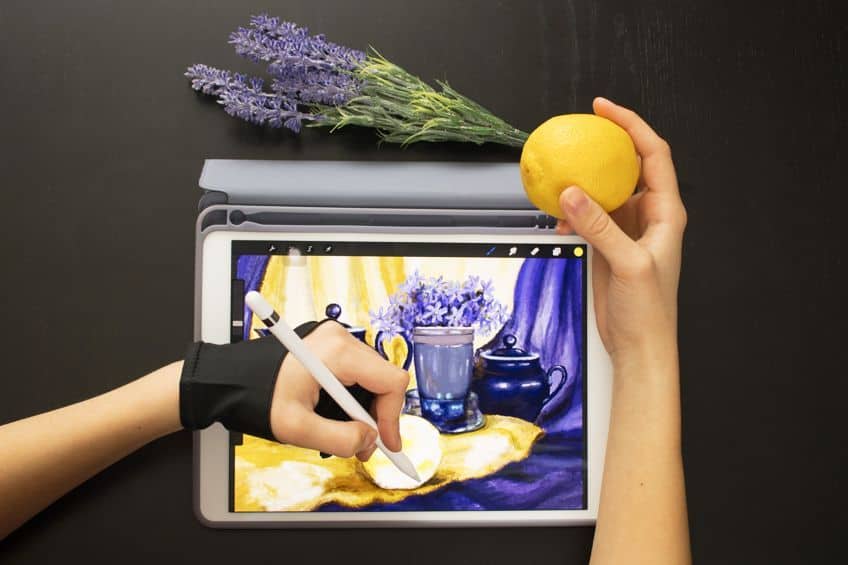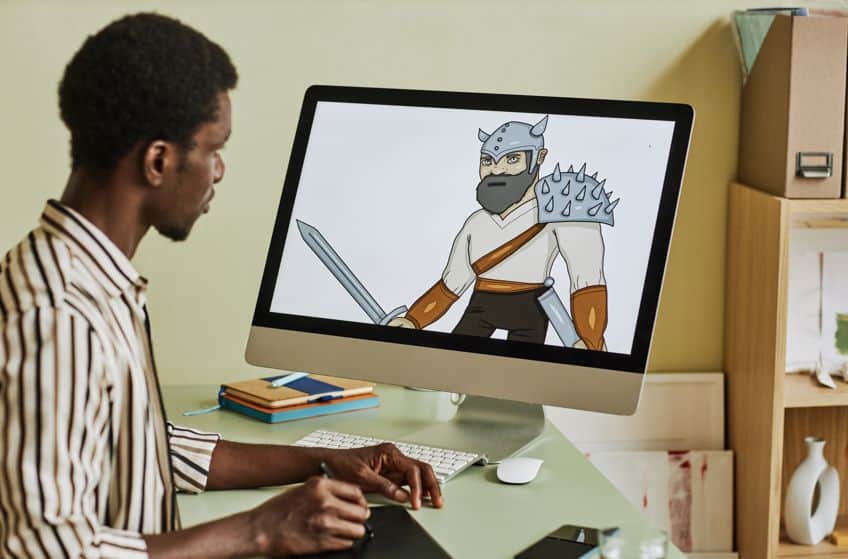How to Sell Digital Art – A Guide to Selling Digital Art Online
Are you an artist interested in converting your artwork into digital art, or are you simply interested in learning how to sell digital art? This can be a new way to grow your client base, or it can be the beginning of a new business for you. However, how to make money with digital art might seem a bit difficult. Even though it seems challenging, it could also be rewarding and worth your while. To gain a better understanding of the whole process, read further to discover more about selling digital art.
Table of Contents
A Growing Market for Digital Art
Most people have some kind of digital footprint, for example, you will be hard-pressed to find somebody who is not on Facebook, never mind all the other social media platforms that are booming. There is most definitely a market for online digital art, and it is continually growing.
Digital art can be described as any art that can be transferred or created in a digital medium. This could mean scanning a painting onto the computer, using a photo, or creating a piece of art within a digital program. There are many graphic design tools you can use to achieve this. This can then be advertised via social media, your own online portfolio website, or on a third-party e-commerce sight. Let us have a look at some of the digital art category examples you can use.
- Paintings or drawings: You can take physical artwork or paintings, which you can then scan onto the computer. This image digitization is what buyers will see online and can be sold as digital prints.

- Photographs: Cameras are also great technological tools nowadays, so it is not difficult to take and use photos as digital art. There are many effects, filters, and tools you can use for this.
- Computer graphics: Artwork done in a digital program from scratch, such as vectors, brushwork, 2-D, and 3-D digital artworks.
- Crypto art: Mostly computer-generated art that can take on various formats to create something unique, which is kept in a secure blockchain registry. Also known as NFTs, or non-fungible art tokens that prove an art piece is unique. A type of digital authentication.
The Benefits of Selling Artwork As Digital Downloads
These benefits are mostly for artists who are already selling their physical art pieces, drawing, or paintings. When selling digital prints online, it helps to broaden the audience, you will most probably have interest from your regular clients, and you now have an open window to more clients. Some people cannot afford to purchase the original work, but it is affordable to purchase a digital download they can then print themselves.
These people could also love your work so much after purchasing a digital download, they might consider getting an original piece.
Selling digital prints online does take work, but it is a relatively easy process to follow. The opportunity also provides a way to earn a passive income, as you can sell digital prints over and over again. Other benefits of selling art online include some of the following.
- Digital sales help to connect art buyers around the world. You are not reliant on a local art gallery for exposure.
- Artists can earn more, as they do not need to pay a commission to an art gallery.
- Some of the advertising or marketing can be free via social media avenues. Selling is also done 24 hours a day.
- Building an online website is easy and affordable to do, but there are also many e-commerce websites to choose from.
- Costs in general are lower when selling digital art.
There are also a few disadvantages or challenges to selling digital art. One of the most significant aspects for some artists is the lack of personal connection. Selling online there is no face-to-face interaction between an artist and the buyer, and it becomes very impersonal. Other challenges can be some of the following.
- Since selling digital art online has become so popular, many artists are doing it, which creates a huge amount of competition.
- Online, buyers cannot see and feel or look at the product properly. There is also less excitement in the whole purchasing process.
- Sometimes, there are just too many choices, making it difficult for the client to decide on something.

- The pricing of the artwork is also different, and an artist cannot charge too much or too little.
- You will have to learn more about marketing and advertising and selling to the right people so that you get noticed.
- High-resolution images can slow a website down, which can pose a problem with keeping a client. Many people do not want to wait for something to load for too long.
- Algorithms can also pose a problem; you have to comply with certain criteria that can become challenging.
Finding Your Niche
You are not going to get rich quickly overnight by selling digital art, but it can become a profitable business. Statistics have proven that online art sales are a billion-dollar industry that has been increasing every year. If you already have online followers on a social platform, you are already on your way. There are already many successful artists that are selling digital art online, proof that it is in demand.
As with many types of business, you should consider your target market or find a niche to help grow your presence online with good marketing strategies and promotions. Do some research and choose a business model that will work for you. Once the foundation is down, the rest should come a little easier.
Unfortunately, if you are not a salesperson it can be difficult, but it is a big part of the business.
First, figure out what makes your art unique, and do you have a signature style? Asking these types of questions can help determine a definition of your work. You should also determine your target market, understand what their needs and wants are, where they devote their online time, and how much you think they will spend on what you have to offer.
The aim is to help the customer base that is best suited to your product, it is not about trying to please customers all the time. Discovering your niche and base customer type is much better than trying to throw out random products and ideas, and hoping something will stick.

Whatever you do, you are not guaranteed it is going to sell. However, if you do have experience and knowledge about your customers, the chances will begin to turn in your favor. The best way to be successful is to create a product your clients cannot easily find elsewhere. The product should also be in your unique style, and you should enjoy what you are doing, which also comes through in the end. You also need to examine the competition and see what they are doing.
You will need to work on cultivating a loyal customer base. You can then also search for existing and developing trends. Once you have established your niche, you can then fine-tune your marketing strategy, and try different things to broaden your exposure. Following this process can help to build your online presence, so you can aim all your efforts in the proper direction, at the right audience.
Creating Your Art
When creating your digital art, you need the proper tools to help maximize your potential. This means investing in a good computer and software to help you create excellent artwork. A good computer is essential, something that can manage the software you are going to be using. You do not want a slow and frustrating computer that could crash at any moment. This means getting a computer with a fast processor, and enough RAM (random-access memory), so it handles larger files. When you choose a computer, it should also have a large monitor, so that you can view your work properly. The proper monitor should also provide color-accurate images, so make sure to consider these things when purchasing a computer.
A good keyboard, mouse, computer stand, and desk chair are also essential to help enhance your work experience.
Drawing Software
There are quite a few digital software choices, from simple to more complex, so there should be one out there that can suit your needs. Some of the more popular software programs include Adobe Photoshop, Adobe Illustrator, Procreate, GIMP, Krita, Coral Painter, and Art Rage among many others.
Drawing Tablet
If you enjoy digital painting and drawing, to produce artwork more smoothly, a drawing tablet might be what you need. You can draw directly onto the tablet, which can then be directly transferred onto your computer screen. The drawing tablet is a lot more precise than using a mouse, and even better when used with a proper stylus. The stylus is a digital pen, which provides more control and precision. Many of the art brushes, available for download, even have a real feel to them when using the stylus.

The specific tablet you need might depend on your style, as you might need something with good pressure sensitivity, or you might want a large screen area. You will need to consider your budget as well, as some tablets are a lot more expensive than others. Tablets also work on different operating systems, which might not work with a computer you have.
Saving Your Artwork
You might want to consider an external hard drive for storing all your digital artwork files. This helps you keep the files in one place, where you can easily access them and edit them if you wish. This also helps save the files from being damaged or lost if something happens to your computer. Another idea is to store your files in cloud storage, which is even safer and can be accessed anywhere.
How to Digitize Your Artwork
If your artwork is a standard letter size or smaller, you can use the scanner to create a digital file of your artwork. The artwork can be laid flat on the scanner, which makes an adjustable lid important. If you have larger artwork pieces, you cannot place them on a simple scanner, you can then take them to a printing shop. You can also try breaking up the work and scanning the artwork in sections, but you will need time and patience for this. You should also consider taking off the scanner lid or cover for this process.
The last idea is to take an extremely high-resolution photo of the artwork. You will need a very good camera for this and you cannot just use a phone camera.
Scanner
If you want to digitize your original traditional media paintings or drawings, you will need a good scanner that produces photo-quality images. A good scanner should provide high-resolution and accurate scans of your work, which you can then edit on your computer. The scanner must also be capable of scanning different sizes and have an adjustable lid. Finding the right scanner can help to bring your artwork to life onscreen.
How to Create Compelling Digital Art
Nobody is really an expert, as there is always something new to learn. To avoid being left behind, especially in the modern digital world, it is best to constantly learn new things, grow, and become more creative in your ideas. Some skills needed are specific to digital artists, however, there are also a few more general things that can help you create more compelling art. Let us have a look at a few ideas to help you to stay at the top of your game.
- Always draw or sketch regularly, whether it is with a pencil or stylus. This is a great way to enhance your skills.
- Make sure to work on your various styles of drawing or painting from figure drawing to portraits, animals, and anime.
- Understanding composition is essential for all art types and styles. Learn or refresh your awareness on the subject. For example, how to use the golden ratio.

- Develop attention to detail, which is also essential to creating great digital art.
- Make sure you have a sound knowledge of photography and design, which can help you create more appealing digital art pieces.
- You also need technical skills, which include knowing how to use different editing and design software. You will even need some coding skills if creating your own website.
- Even though you are offering digital art, communication remains a good skill to have. You need to take feedback and work with clients to help recognize their needs.
- Make connections with other digital artists to see what is available out there.
Creating a Portfolio to Showcase Your Work
Once you have created your artwork, you need to have somewhere you can display it. If you want to learn how to make money with digital art, you should consider creating an online portfolio. This can help you gain recognition and can usually display a range of work. This is a great way to present all your work to potential clients and curators or art collectors.
You can build your own website to achieve this, but this can take time and effort.
You will also need to add e-commerce functionality to your website if you also want to sell online. The benefits of your own website includes you having complete control over everything. Another option is to use a portfolio or third-party e-commerce website. This might be easier and cheaper to begin with. When creating an art portfolio, the following pages should also be included on the website.
- About page and contact pages: This is to help inform people about your professional background, a little about yourself, and how you work.
- Include a CV: To help visitors get an overview of your skills and educational background.
- Press page: This is optional, but it can include reviews about your work and any interviews you might have participated in.

Some portfolio websites you can use to create a portfolio, but you cannot sell directly from the platform. For example, if you have an Adobe Creative Cloud subscription, you can use the Adobe portfolio platform to create a great portfolio, but you cannot sell directly from it. Some of these websites have free plans along with other paid options with additional features. Check out some reviews to find a portfolio website best suited for your needs. Have a look at a few more portfolio websites below, where you can also network and find inspiration from other artists.
- Dribble
- Squarespace
- Behance
- Deviant Art
- Crevado
- Brushd
- Dunked
- Carbonmade
What Type of Digital Art Sells?
When choosing the proper platform, it does depend on the type of digital art you make. Are you more of a graphic designer or do you produce more traditional digital artwork? However, there are certain top-selling digital art products, like the ones below.
So, if you offer more personalized artwork, for example, digital cards, you can consider offering commissions as a business strategy.
- Editable images
- Website templates
- Fonts
- Wallpapers
- Stock images
- Fan art
- Digital cards
- Coloring pages
Where to Sell Digital Art
Marketing and sales are a part of the business if you want to make money as an artist. You can start using social media like Facebook and other image-sharing platforms like Instagram straight away. Both of these have options to set up a shop. Below are some ideas where to sell digital art.

Marketplaces or E-commerce Sites
Besides social media platforms, you can try e-commerce stores like WooCommerce, eBay, Amazon, Shopify, or Etsy. This is a low-cost way to begin selling digital art, and there is already a market that has an international reach. However, in many cases, the built-in tools are not sufficient or poor, and you cannot customize it completely to your needs, so you have no real control over the website.
There might be rules you need to follow, and costs can work out quite high with the company asking for multiple fees, and a commission on sales as well.
Stock Images
Depending on your art style, for example, if you are a photographer, you can join a stock images site like Shutterstock, Getty Images, Dreamstime, or Adobe Stock. These are also great for artists who do vectors and illustrations. However, there is a lot of competition, and it will be difficult to stand out.

Creating a Website
You can choose a website hosting company, which requires a monthly payment, and then use a website builder to create your own website. The most popular choice is WordPress, which is simple and easy to use. There is also the WordPress eCommerce plugin you can download for convenience. Customize the website however you want, with no restrictions.
One disadvantage is if you are using WordPress for the first time, it can take a while to learn all the ins and outs of the program.
Offer Commissions
Offering personalization is a big selling point, for example, creating banners or thumbnails, and profile building. You can take original art ideas and promote them on social media. You can then ask a commission from anybody interested in your work. When asking for payment, the best thing to do is go for a fixed rate that can be determined by your resources and time used. For receiving payments, you can use links to different payment gateways. You can also similarly use this idea on the portfolio websites.

Expanding Your Offerings
You can use your digital artwork to sell physical items. Many on-demand printing companies can print your artwork on a variety of merchandise items like T-shirts, notebooks, cellphone cases, socks, and mugs, and you do not have to worry about the printing, handling, or shipping of the product. This can also be a way to create passive income, as your artwork is uploaded, and selling is available 24 hours a day. Dropshipping is another method that can be learned quickly, where you do not have to keep the stock yourself.
Think about how you can use your artwork to create cards, posters, wall art, and art canvas prints.
Protecting Your Art
What is stopping somebody from simply copying and pasting an image you have placed online? There are many scam artists whom you will need to deal with if you want to sell digital art. Some of the safeguards you can use are shown below.

Disable Downloads
You can go onto your website and in the setting, you should be able to disable the downloading of your images. So, if people right-click on the image, they cannot save or download it. However, there are still ways people can work around this to steal the images.
Adding Metadata
Metadata is information that has been embedded in the saved image file and includes different things like author information and copyright information. Many people do not even know about adding metadata, so it can be a great way to protect your art. However, this does mean that your file size will increase, which can also affect download time.
You can add metadata or consider using a non-fungible art token (NFT), which is also essentially metadata that is encoded with the digital artwork.
Using Low-Quality Images
When you are using images for advertising, consider placing low-quality images for preview instead of the proper image. You can then send the correct high-resolution image after you have received payment for your artwork.
Adding Watermarks and Signatures
If you go onto some creative websites where images are for sale, you will notice some of them have a signature or watermark displayed, which cannot easily be removed. This is one of the advantages, however, a disadvantage is that it can look ugly and distracts from your artwork. Adding a watermark is completely up to you.

Copyright Your Artwork
The best way to protect your work if you do not want it stolen and sold by others, is to copyright it. Even if somebody does try to steal your work, you have something you can do to try and stop it. This has a lot more success than some of the other methods. However, you must make sure your work is registered at a copyright office to get the protection you are looking for.
If you find that somebody is trying to sell your work, you can then prove that the images in question are yours.
Remember, if somebody purchases a digital art piece from you, they will own the art, but not the rights to the image. That can only be done if the artist transfers the copyright over to the buyer. Looking out for infringements online can be tiresome, however, you can consider something like Red Points, an image recognition program that can automatically find copyright infringements for you.
Setting Prices and Payment Methods
If you are asking for commissions or have set up your website, you will need to have payment methods available to be able to sell your digital downloads. Digital downloads do not need to be shipped or have any other issues, so you can use most payment gateways like Paypal, CashApp, or digital wallets like Venmo. When advertising, use a fixed price and safe payment method. Many of these payment methods now also offer crypto-currency payments.

You could send email invoicing and use electronic bank transfers; however, these can be unreliable. To prevent any problems as much as you can, preferably opt for a well-known and reliable payment gateway platform. The online e-commerce marketplaces usually have this part taken care of within their system. You can also direct your followers to support sites like Ko-fi or Patreon, where you can accept donations and memberships, and sell your art.
Pricing Digital Art
Pricing digital art can seem difficult, as you need to factor in things like time, and the value you bring to the table. You should also look at the current market for similar items. Also, do not forget that your reputation as an artist can also play a role in pricing. If you are joining a marketplace site, you should also consider all the costs involved.
If you are going to ask for commissions, a basic way to do this is to make sure you know how much time was spent on making the artwork and then multiply this by a calculated hourly rate.
The minimum hourly rate can be determined by deciding on an amount you need to make from commissions each month to cover living expenses, then double this figure. Lastly, divide this by the hours you work on the commissions each month, which is not usually more than 100 hours.
Building Your Online Presence
Before you begin, you must develop a business plan. This is to help you build a strategy on how you can grow and determine future financial needs. It can be a step-by-step map of what you need to do, and the resources required, and helps you determine the goals you wish to achieve. You also need to create a marketing strategy to help get your business out there, so it is seen and not lost among all the others. So, try not to skip these important steps.

Building a Professional Website
You can get a professional to build a website for you, which could save you time, but it will cost you more. You can also build your own website; however, this could take some time to understand and complete. You will have to start by working on building a brand strategy, identifying your target market, and researching your competitors, among other things.
You will also have to think of the following, which can help you produce a professional website.
- You will need to consider your design layout and colors by choosing templates or customizing a design.
- Improve usability by considering the site structure and placement of tabs, readability, and making sure you have a call-to-action.
- Consider search engines by doing keyword searches and SEO optimization.
- Since many people are always on their phones, you will need to optimize for mobile.
- Create compelling content to attract and keep customers interested.
- You must maintain, as well as update, your website all the time.
- Create an email marketing strategy to help build long-term relationships with customers.
Building a Social Media Presence
There are quite a few social media platforms out there, depending on what you have to offer, some are better than others. For example, for photographers, visual platforms like Pinterest or Instagram are best. The major popular platforms are Facebook as well as Instagram, so you can always start there if you are uncertain about anything.

Like your website, you should optimize your social media page, making sure all the information is correct and that any images are professional in appearance. There are social media professionals you can hire to help you build an online presence quicker and more easily. But let us list a few more tips you can use if you decide to give it a try on your own.
- Always check on current trends and see how you can improve on them.
- Make sure you are active and post regularly and promote often.
- Use multimedia methods like visuals and videos that get more traction.
- Pay attention to the customer side of things, engage with customers, and deal promptly with feedback and complaints. Communication is important.
- Take note of analytics, which helps you see what is working and what is not.
- You can now pre-plan and set up a posting schedule, which can also be done over multiple social platforms.
- Do not force sales or “push a hard sale” as they say.
Marketing Your Art
How to sell digital art? Your website or portfolio, and social media platforms are all a part of a marketing strategy. Once you are set up, you will need to add content. You can try starting a blog on your website that provides unique information and promotes your personal brand. Maybe you can offer tutorials or other relevant information to attract customers. Try to add these ideas to your marketing strategy.
- Create videos: Consider using YouTube or TikTok to generate views and increase traffic to your website. You can also embed videos onto your website.
- Guest post: You can guest post on other websites, which can also help to generate traffic to your site.
- Online forums: Join and participate in online forums, offer advice, and share your knowledge.

- Comments: When you are on other art blogs make comments, which is another way to network.
- Influencer affiliates: You can use influencers to leverage their large social following, which can help to build your brand awareness and generate quality leads that can lead to sales.
Creating and selling digital art is not as simple as you might think. It is not something that will make you rich overnight and requires hard work and dedication. However, if you put the work in, you will reap the rewards. The most important thing to remember is to have fun while doing it!
Frequently Asked Questions
How Can I Protect My Digital Art from Being Stolen?
There are many ways to protect your digital artwork. If you are a professional, registering a copyright is the best way to go. However, you can also add watermarks and metadata to your work as a precaution.
What Pricing Model Should I Use for My Digital Art?
There are different pricing models, depending on what you plan to sell and where you are going to sell the art. You also need to consider your time and the value you bring to the item you are selling. The current market trends are also important, as well as the artist’s skills and experience.
Where Can I Promote My Digital Art?
There are many social media platforms you can use. Some are more suited to visual posts like Instagram, but you can also use Facebook, Twitter, YouTube, TikTok, Pinterest, LinkedIn, and Tumblr, among others.
In 2005, Charlene completed her Wellness Diplomas in Therapeutic Aromatherapy and Reflexology from the International School of Reflexology and Meridian Therapy. She worked for a company offering corporate wellness programs for a couple of years, before opening up her own therapy practice. It was in 2015 that a friend, who was a digital marketer, asked her to join her company as a content creator, and this is where she found her excitement for writing.
Since joining the content writing world, she has gained a lot of experience over the years writing on a diverse selection of topics, from beauty, health, wellness, travel, and more. Due to various circumstances, she had to close her therapy practice and is now a full-time freelance writer. Being a creative person, she could not pass up the opportunity to contribute to the Art in Context team, where is was in her element, writing about a variety of art and craft topics. Contributing articles for over three years now, her knowledge in this area has grown, and she has gotten to explore her creativity and improve her research and writing skills.
Charlene Lewis has been working for artincontext.org since the relaunch in 2020. She is an experienced writer and mainly focuses on the topics of color theory, painting and drawing.
Learn more about Charlene Lewis and the Art in Context Team.
Cite this Article
Charlene, Lewis, “How to Sell Digital Art – A Guide to Selling Digital Art Online.” Art in Context. May 30, 2023. URL: https://artincontext.org/how-to-sell-digital-art/
Lewis, C. (2023, 30 May). How to Sell Digital Art – A Guide to Selling Digital Art Online. Art in Context. https://artincontext.org/how-to-sell-digital-art/
Lewis, Charlene. “How to Sell Digital Art – A Guide to Selling Digital Art Online.” Art in Context, May 30, 2023. https://artincontext.org/how-to-sell-digital-art/.









